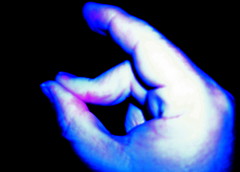 Image by Tojosan via Flickr
Image by Tojosan via Flickr
I just found out that one of my friends has been using echolocation her whole life. She assumed everybody could do it. She uses finger snapping.
It is actually fairly clean and I can navigate without bumping into too much stuff and with some speed.
I tried snapping today and made a couple observations about it. First, it does seem to be pretty useful, it also gives you the ability to move your hand position around so that it is in front of your body or off to the side which blocks the sound from the opposite side of your body giving you resolution of whichever direction you choose as opposed to having to click with your tongue.
Another thing you can do is put your snapping hand out in front of your face and put your other hand between you and your snapping hand so that the initial sound is blocked from your ears and you only get the reverberations from the surroundings. This tends to bring out a little more clarity.
Not to mention that it is much more natural and socially acceptable than tongue clicking.
![Reblog this post [with Zemanta]](http://img.zemanta.com/reblog_e.png?x-id=67fa8d89-890b-409d-8026-cd387c496e6f)

![Reblog this post [with Zemanta]](http://img.zemanta.com/reblog_e.png?x-id=3a6694c4-e1ca-4380-8398-e18cf298d1d4)
